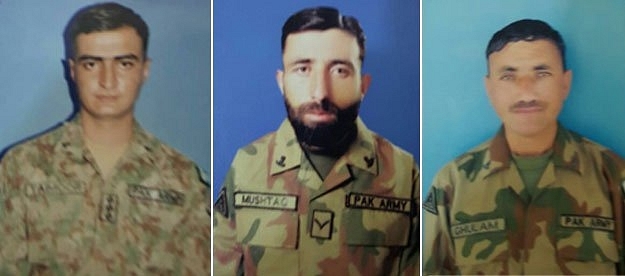Insta
Three Pakistani Soldiers Killed In Indian Army’s Counter Offensive

(Left- Right) Captain Taimoor ali, Havildar Mushtaq Hussain and Lance Naik Ghulam Hussain (Photo: ISPR)
Three Pakistan Army soldiers were killed today (23 November) as the Indian Army responded to the death of three of its soldiers. The Indian soldiers were killed by a Pakistan’s border action team that had crossed into the Indian side of the border yesterday.
According to Dawn, a prominent Pakistani daily, the Inter Services Public Relations wing of the Pakistan Army has confirmed the death of three soldiers.
The soldiers killed during the cross-border fire were identified as Captain Taimoor Ali, Havildar Mushtaq Hussain and Lance Naik Ghulam Hussain.
However, ISPR also claimed that Pakistan Army killed at least seven Indian soldiers as it retaliated to ‘unprovoked’ firing from the Indian side.
Pakistan has suffered huge losses in Shahkot, Jura, Battal Karela, Bagh and Bagsar sectors due to Indian shelling, Dawn reported.
Intense exchange of firing continues, it added.
As reported earlier, the Indian Army has launched a massive counter offensive along the Line of Control (LoC) after Pakistan killed three of its soldiers and beheaded one in Machhal sector of Jammu and Kashmir.
Reacting to the death of three soldiers on Tuesday, Indian Army had warned Pakistan of strong retribution. This is the largest counter offensive launched against Pakistan since the two nuclear powers came to the brink in 2002.
There have been a whopping 286 incidents of firing and shelling along the LoC and the International Border in Jammu and Kashmir by Pakistani troops that have resulted in the death of 26 people, including 14 security personnel, since the surgical strike on terrorist launch pads in Pakistan-occupied Kashmir on 29 September.
Support Swarajya's 50 Ground Reports Project & Sponsor A Story
Every general election Swarajya does a 50 ground reports project.
Aimed only at serious readers and those who appreciate the nuances of political undercurrents, the project provides a sense of India's electoral landscape. As you know, these reports are produced after considerable investment of travel, time and effort on the ground.
This time too we've kicked off the project in style and have covered over 30 constituencies already. If you're someone who appreciates such work and have enjoyed our coverage please consider sponsoring a ground report for just Rs 2999 to Rs 19,999 - it goes a long way in helping us produce more quality reportage.
You can also back this project by becoming a subscriber for as little as Rs 999 - so do click on this links and choose a plan that suits you and back us.
Click below to contribute.
Latest